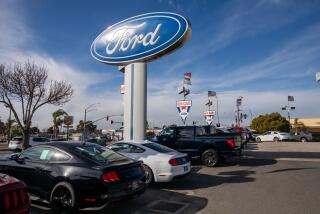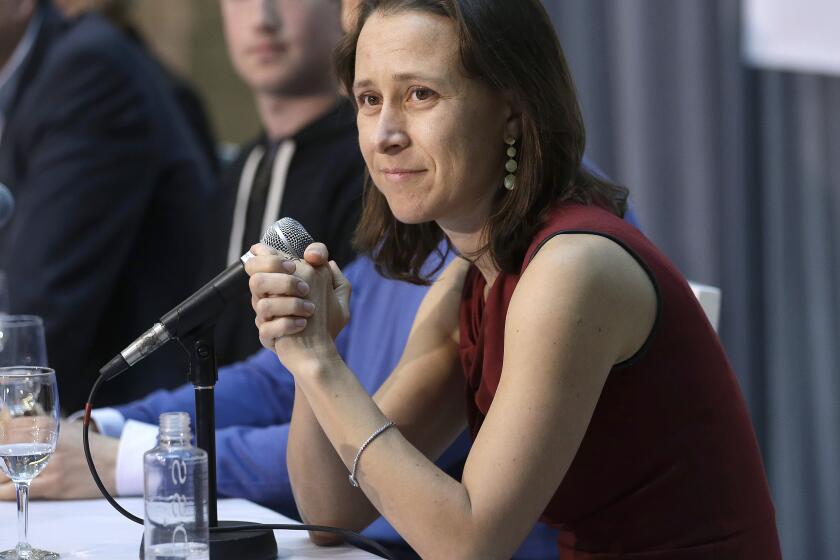More People Turn to Leasing as an Answer to Rising Automobile Prices : Consumers: The financing plan will account for nearly one-fourth of new-car sales this year, up from around 12% in 1987.
- Share via
DETROIT — Bob Matthews says he’s known for six years what many car buyers only now are discovering: Leasing can save money and hassles.
The retired government worker and his wife have a three-year lease on a new Oldsmobile 88 Royale at $300 a month. Buying the $19,050 car over the same period would have cost around $435 a month at prevailing interest rates.
And when the Matthews’ contract is up in May, 1995, they have the option of returning the Royale or keeping the car after paying what it’s still worth.
“Any time you have a car 3 years old or so, the tires or the battery or something goes out on you,” said Matthews, of Troy, Mich., who’s been leasing cars since since 1986. “Before that happens, I have a new car.”
More and more motorists are doing the same thing.
Once used almost exclusively by governments and big companies in amassing car fleets, leasing has caught on among individuals in recent years.
In fact, retail leasing is expected to account for nearly a quarter of individual new car sales this year, up from around 12% in 1987, said Art Spinella, director of automotive research at CNW Marketing-Research in Bandon, Ore. Some experts predict that by the middle of the decade, half of new car sales will be leases, largely because cars will keep getting more expensive.
“What happened was that in the last seven or eight years, the average income for John Doe went up 2 or 3 or 7 percent, while the average price of a car went up 35 or 40 or 50 percent,” said Rudy DeGroot, co-owner of an independent leasing company in Scottsdale, Ariz.
But leasing isn’t for everyone. A person who drives a car as long as it will run isn’t a good candidate, nor is someone who drives more than 15,000 miles a year. A lease with higher mileage allowance costs more, and going over the limit is fined.
Obtaining a lease also requires a better credit rating than a car loan because the auto maker risks getting back a car worth less than the value projected at the time the lease is signed.
And terms, such as capitalized cost reduction, closed end, open end and residual value, can be confusing.
Still, enough sticker-shocked buyers have walked out of showrooms during the recession that many dealers have trained their salespeople in leasing options. Some provide perks like VIP cards for lease customers to speed shop service.
Ramsay Gillman, who owns 13 car dealerships in southern Texas, said he hired an agent for each of his stores to explain the specifics of leasing.
“They function the same as a finance and insurance person,” he said. “There are a lot of specific disclosures. To do it legally and properly, we decided to use a lease agent.”
The auto makers also are promoting leasing.
In February, Oldsmobile offered a nothing-down, $199-a-month lease on the new Oldsmobile Achieva. Subsidizing the interest rate and inflating the projected value at the end of the lease cost Oldsmobile $2,900 on each $13,290 car, said Buz Doering, a leasing consultant from Milwaukee.
In the luxury segment, Mercedes-Benz recently offered a 36-month lease on its 300E sedan, which lists for nearly $50,000. Doering said Mercedes put almost $15,000 per car in subsidies into the lease program.
Customers have been enthusiastic about both offers, the auto makers say. In Mercedes’ case, the lease helped the German luxury-car maker avoid the appearance of cheapening the prestige of the car, as it might have by offering a huge rebate.
Rebates, a part of the car-buying equation since the mid-1980s, drove up auto makers’ costs. Leasing subsidies are helping them regain control of pricing.
A lease is entered in auto makers’ books as a sale, even though they get the cars back at the end of the lease term.
Doering said that as leasing grows in popularity, the new-car turnover cycle will shorten.
Dealers learned a hard lesson from the ‘80s when they signed customers to long installment contracts--the customers didn’t come back as often. And when they did come back, their paid-off cars had little trade-in value to apply toward a down payment on another new car.
Also, many bargain-hungry buyers bought used cars rather than new ones.
For the consumer, leasing can offer several advantages over buying:
* It frees up cash that would go into a traditional down payment, typically 20% of a car’s sticker price.
* Sales tax is pro-rated for the length of the lease. A car buyer pays sales tax on the whole vehicle.
* Monthly payments are often low because dealers inflate the projected value of the car at the end of the lease.
Auto Leasing Experts predict leasing will account for one out of every two new car sales by the middle of the decade. 1992 Cars leased (percent): 1,490,000 (23.8%) Total car deliveries: 6,300,000 1991 Cars leased (percent): 1,112,000 (19.7%) Total car deliveries: 5,700,000 1990 Cars leased (percent): 980,000 (17.8%) Total car deliveries: 5,500,000 1989 Cars leased (percent): 1,115,000 (18.8%) Total car deliveries: 6,100,000 1988 Cars leased (percent): 1,270,000 (16.9%) Total car deliveries: 7,500,000 1987 Cars leased (percent): 1,130,000 (14.2%) Total car deliveries: 8,000,000 1986 Cars leased (percent): 870,000 (11.9%) Total car deliveries: 7,400,000 * 1992 figue is a projection as of May 1.
More to Read
Inside the business of entertainment
The Wide Shot brings you news, analysis and insights on everything from streaming wars to production — and what it all means for the future.
You may occasionally receive promotional content from the Los Angeles Times.










